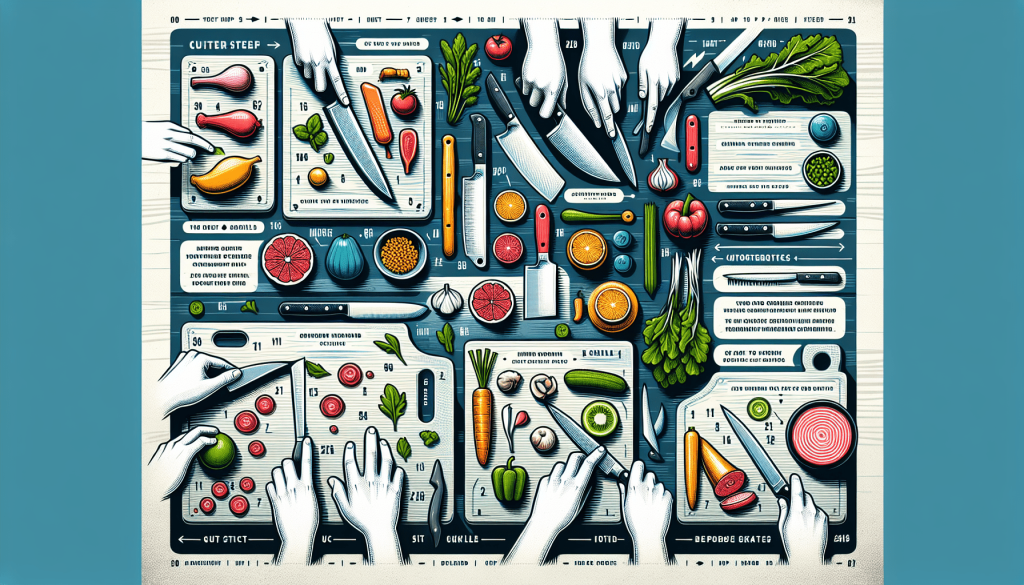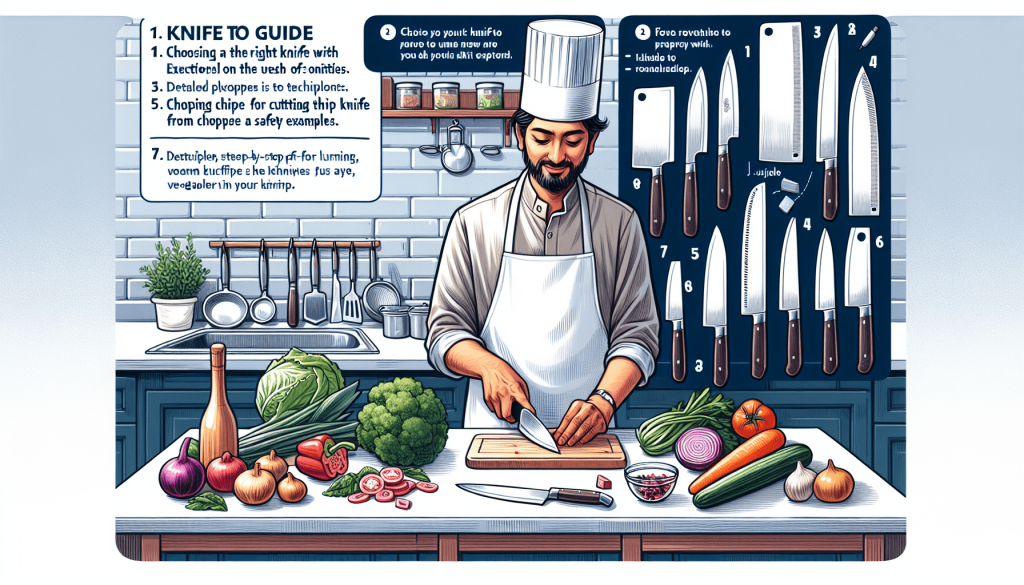In this article, you will discover the secrets to becoming a master in the kitchen when it comes to knife skills. From mastering the proper grip and knife techniques to learning how to chop, slice, and dice like a pro, this ultimate guide will equip you with the knowledge and confidence to tackle any recipe that comes your way. So grab your favourite chef’s knife and get ready to slice and dice your way to culinary greatness!
Introduction
Welcome to the ultimate guide to mastering knife skills in the kitchen! Whether you’re a seasoned home cook or just starting out, having the right knife skills is vital for creating delicious meals with ease and precision. In this comprehensive article, we’ll cover everything you need to know – from choosing the right knife to advanced techniques and even knife skills in different cuisines. So let’s dive in and sharpen those skills!
Choosing the Right Knife
When it comes to choosing the right knife, it can be overwhelming with the array of options available. Understanding the different knife types is crucial in finding the perfect fit for your needs. From chef’s knives to utility knives, each has its own speciality. Consider the tasks you’ll be performing the most in the kitchen and select a knife that suits those needs.
Size also matters when it comes to knives. Selecting the appropriate knife size ensures that you have the right balance and control while cutting. A smaller knife can be great for precision tasks like peeling or trimming, while a larger knife is perfect for chopping and slicing.
Blade material is another factor to consider. Different materials have varying levels of durability, sharpness, and resistance to corrosion. Stainless steel is a popular choice for its affordability and low maintenance, while high-carbon steel offers excellent sharpness and edge retention.

Knife Maintenance
Once you have the perfect knife, it’s essential to keep it in top condition. Regular maintenance will extend the life of your knife and ensure optimal performance in the kitchen. Sharpening your knives regularly is crucial for maintaining a sharp edge. Invest in a good quality sharpening stone or honing rod and practice your technique to keep your knives razor-sharp.
In addition to sharpening, honing the blade is important for realigning the edge and keeping it straight. This can be done with a honing rod, using light pressure and a consistent angle. By honing your knife regularly, you’ll not only keep it sharp but also improve the overall cutting performance.
Properly storing your knives is another key aspect of maintenance. Avoid throwing them in a drawer where they can get damaged or cause accidents. Invest in a knife block or a magnetic strip to keep your knives organized and easily accessible. Be sure to store them with the blade protected to avoid any potential injuries.
Gripping Techniques
Having the right grip is essential for control and safety while using a knife. There are several gripping techniques to choose from, depending on the task at hand.
The basic grip involves holding the handle firmly with all fingers wrapped around it. This grip provides stability and control, making it suitable for most tasks.
The pinch grip is commonly used for precision tasks. To achieve this grip, hold the blade between your thumb and index finger, while the rest of your fingers securely hold the handle. This grip allows for precise cutting and finer control.
The claw grip is particularly useful when working with round or irregular-shaped ingredients. With this grip, curl your fingertips under, creating a claw-like shape. This grip provides stability and protects your fingertips while ensuring precise cuts.

Basic Knife Cuts
Mastering basic knife cuts is fundamental for any home cook. These cuts form the foundation for many dishes and recipes, ensuring even cooking and appealing presentation.
The slice is a straight cut made by drawing the knife blade in a forward and downward motion. It’s perfect for achieving thin, even slices of ingredients like tomatoes or cucumbers.
The chop is a downward motion cut used to dice or chop ingredients into smaller pieces. It involves a rocking motion, with the tip of the knife touching the cutting board and the rest of the blade rising and falling.
The julienne is a technique used to create long, thin strips of vegetables or fruits. Start by cutting the ingredient into uniform rectangles, then make long, thin slices to produce the julienne.
The dice involves cutting ingredients into small, uniform cubes. Begin by creating a julienne, then stack the strips and cut them into squares.
The chiffonade is a technique used for cutting leafy greens or herbs into thin, ribbon-like strips. Stack the leaves, roll them tightly, and cut thin slices perpendicular to the roll.
Advanced Knife Skills
Once you’ve mastered the basic cuts, it’s time to level up your knife skills with some advanced techniques. These techniques will elevate your culinary game and impress family and friends.
The butterfly technique, also known as spatchcocking, involves splitting a whole chicken or turkey down the backbone to flatten it for even cooking. This technique reduces cooking time and ensures juicy, evenly cooked poultry.
The roll chop is a precise technique commonly used for cutting large, round ingredients like onions. By making a series of cuts in a half-moon shape while rolling the ingredient, you can achieve uniform, finely diced pieces.
The brunoise is a technique used to create small, uniform cubes, usually for garnishes or adding texture to dishes. It involves creating a small julienne, then cutting it into small cubes.
The roux is a mixture of fat and flour used as a base for sauces and soups. Achieving the perfect roux requires finely dicing the ingredients, allowing them to cook evenly and release their flavors.
Knife Safety
When it comes to knife skills, safety should always be a top priority. By following proper hand positioning, avoiding distractions, and using safe cutting surfaces, you can minimize the risk of accidents and injuries.
Proper hand positioning involves holding the knife with a secure grip and tucking your fingertips under to protect them. Keep your other hand in a claw-like shape while holding the ingredient, guiding the knife away from your fingers.
Avoiding distractions is crucial to maintain focus while using a knife. Create a dedicated workspace, free from distractions like phones or other electronic devices. By concentrating on the task at hand, you’ll reduce the risk of accidents.
Using safe cutting surfaces is essential for preventing injuries and prolonging the life of your knives. Opt for a sturdy cutting board made of either wood or plastic, as these materials are gentle on the blade and won’t dull it quickly. Avoid cutting on surfaces like plates or countertops, as they can damage both the knife and the surface.
Knife Skills Practice
Building knife skills takes time and practice. By incorporating regular practice sessions into your routine, you’ll gradually improve and become more confident in the kitchen.
Start by practicing the basic knife cuts, focusing on technique and precision. Set aside dedicated practice time, repeating the cuts until you feel comfortable and consistent.
Guided practice exercises can also help you develop your skills further. Follow along with instructional videos or knife skill tutorials, paying attention to proper hand positioning and technique. By following these guided exercises, you’ll refine your skills and become more proficient.
As you progress, challenge yourself with more complex tasks. Gradually introduce ingredients that require different cutting techniques or try preparing more elaborate recipes. By pushing yourself outside your comfort zone, you’ll continually improve and expand your culinary repertoire.
Knife Skills in Different Cuisines
Knife skills vary across different cuisines, reflecting cultural traditions and cooking styles. By exploring different knife skills, you’ll not only enhance your cooking but also gain a deeper understanding of global culinary practices.
Asian knife skills, such as the precise slicing of sashimi or the delicate julienne of carrots in stir-fries, highlight the importance of finesse and knife control.
French knife skills, known for the classic technique of chiffonade for fine herb cuts and the meticulous brunoise, showcase precision and attention to detail.
Mediterranean knife skills emphasize rustic, bold cuts such as the chop for ingredients like garlic or onions, which form the base of many dishes in this cuisine.
Essential Knife Skills for Home Cooks
As a home cook, there are several essential knife skills that you’ll find invaluable in your day-to-day cooking adventures.
Efficiently slicing fruits and vegetables allows for quick preparation of ingredients, making cooking more enjoyable and efficient. By mastering the slice, you’ll achieve consistent, professional-looking cuts each time.
Deboning poultry and meat is a useful skill to have, allowing for more diverse culinary creations. By learning the proper technique and practicing, you’ll be able to remove bones with ease and precision.
Filleting fish requires skill and finesse. By understanding the anatomy of fish and practicing the proper technique, you’ll be able to expertly fillet and prepare fish dishes with confidence.
Slicing bread and pastries is another essential skill for any home cook. With the right technique, you’ll be able to achieve clean, even slices without squishing or tearing delicate baked goods.
By mastering these essential knife skills, you’ll elevate your cooking and gain more confidence in the kitchen. So grab your knife, get practicing, and let your culinary creativity shine!
In conclusion, mastering knife skills is an ongoing journey that will elevate your cooking and make your time in the kitchen more enjoyable. By selecting the right knife, practicing proper maintenance, mastering gripping techniques, learning basic and advanced cuts, prioritizing safety, and exploring knife skills in different cuisines, you’ll become a true culinary pro. So grab your apron, sharpen your knives, and get ready to slice, dice, and chop your way to culinary excellence!
